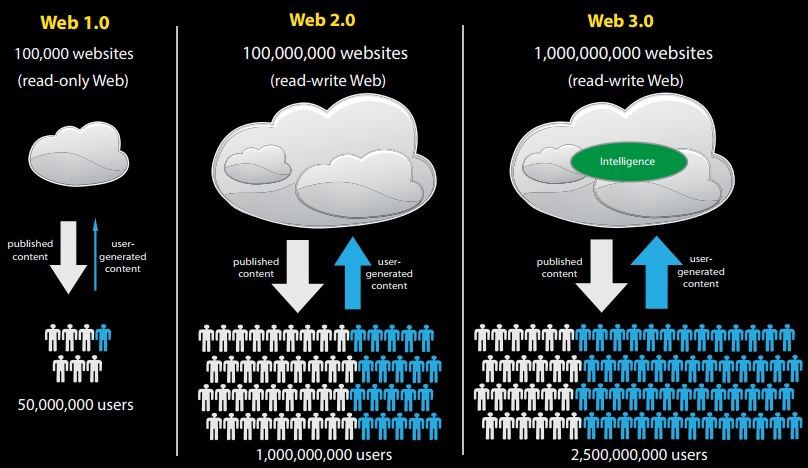Conforming to many, the Web is a continuous pillar of modern life. A beautiful invention of the time and has just existed since. However, the Web today is quite different from what was initially imagined. You might have already read about the history of the web, however, lemme give you a quick refresher on the short past that we remain armed. Let’s get started.
The Web’s history is loosened into periods — Web 1.0 and Web 2.0 before joining the club of Web 3.0 we are into experiencing. To history buffs, the Web story dates back to 1989, at CERN, Geneva, where Tim Berners-Lee was busy developing the protocols that would become the World Wide Web. His idea? To coin an open, decentralized protocol that permissioned information-sharing from anywhere on Earth.
It was roughly between 1990- 2004, Web 1.0, the first inception of Berners-Lee’s creation, took birth. The innovation was static websites owned by companies with zero user interaction. Individuals seldom produced content at that time, leading it to a read-only web. In 2004, Web 2.0 began to emerge, giving a facelift to static websites. Web 2.0 brought into play dynamic social media platforms, upskilling with the capability of read-write. Instead of former times, like companies providing content to users, Web 2.0 began to scale platforms to share user-generated content and engage in user-to-user interactions. It was a celebration of exchange and communication among users giving new hopes and lives. But, it addressed a concern. Web 2.0 birthed an advertising-driven revenue model repelling users of content monetization benefits. A handful of top companies on the dot controlled the content and generated the value. Though this monopoly of companies helped to create a stable, robust infrastructure, it restricted the ownership rights of the users over the content. Trust got quaked sometime, and called for an alternate.

The premise of ‘Web 3.0’ was coined by Ethereum co-founder Gavin Wood, soon launching the Ethereum blockchain in 2014. Gavin addressed a problem that many early web adopters felt: the Web required too much trust. That is, most of the Web that people know and use today relies on trusting a handful of private companies to act in the public’s best interests.
So how do we establish trust and ownership ???? Web 3.0 by and large implies blockchain to give power back to the users in the form of ownership. The blockchain blanket thus defines Web 3.0 to remain –
Decentralized: instead of large swathes of the internet controlled and owned by centralized entities, ownership gets distributed amongst its builders and users.
Permissionless: everyone has equal access to participate in Web 3.0, and no one gets excluded.
Trustless: it operates using incentives and economic mechanisms instead of relying on trusted third-parties.
Web 3.0 at its best is called read-write-own.
Why is Web3 vital ?

Web 3.0 is called to be the future internet as it leverages many technologies to achieve real-world human communication. But it does not fit into any rigid definition. For ease, let’s dissect Web 3.0 into possible categories.
From a blockchain perspective, Web 3.0 embraces decentralization. This brings down the existing monopoly of tech corporations and gives users the power to own their content. Likewise, the conversion from central authorities to the blockchain leads to many other traits, such as
(i) openness: Web 3.0 data is stored in an open network developed by public communities. Also, Web3 applications are executed in a global view towards the public, making data permanently visible to all the participants.
(ii) trustless: a user can build connections or exchange assets with an unfamiliar user without reliance on a trusted third party.
(iii) permissionless: users’ identities are no longer tied to any specific platform, and users’ activities are free and do not need authorization from a governing entity.
(iv) anonymous: users can obtain partial anonymity by using multiple pseudonyms or off-chain storage.
(v) high availability: Web 3.0 provides a high availability architecture, which reduces the probability of a server crash or single-point failure.
(vi) compatibility: Deployed services and applications are not limited to one ecosystem, say Ethereum, but applicable to all competitive blockchains like Avalanche, Solana, Binance Smart Chains indicating that Web 3.0 can integrate both existing public-chain ecosystems and incoming systems.
The Big Impacts of Web 3.0
Ownership
Web 3.0 gives you ownership of your digital assets in an unprecedented way. For example, imagine you’re playing a web2 game. If you buy an in-game asset, it is tied directly to your account. Now assume like, the game creators erase your account, what will happen?…you will lose all these assets. Likewise, if you quit playing the game, you lose the worth you put into your in-game things. Web3, on the other hand, allows for direct ownership through non-fungible tokens (NFTs). No one, not even the game’s creators, has the power to take away your ownership. And, if you stop playing, you can sell or trade your in-game items on open markets and recoup their value.
Censorship resistance
The power dynamic among the Web platforms and content creators is considerably imbalanced. While Web 2.0 requires content creators to trust platforms not to change the guidelines, censorship resistance is a native component of a Web3 stage. On Web3, your data lives on the blockchain. When you leave a platform, you can take your reputation with you, plugging it into another interface point that all the more lines up with your values.
Decentralized autonomous organizations (DAOs)
As well as owning your data in Web 3.0, you can own the platform as a collective, using tokens that act like shares in a company. DAOs let you coordinate decentralized ownership of a platform and make decisions about its future.
DAOs are defined technically as agreed-upon smart contracts that automate decentralized decision-making over a pool of resources (tokens). Users with tokens vote on how resources get spent, and the code automatically performs the voting outcome. However, people define many Web3 communities as DAOs. These communities all have different levels of decentralization and automation by code.
Identity
Generally, you create an account for each Web platform you use. For instance, you could have a Twitter account, a LinkedIn account, and a YouTube account. Sometimes you may need to make certain changes in these accounts?? How do you do ?? You need to sign-in and do it across every account you want the change.
Well this presents to be easy and clean, it comes with an issue — control/censorship. In a single click, these platforms can sometimes lock you out of your whole web-based life. Much more dreadful, numerous platforms expect you to entrust them with personally identifiable information to create an account.
Web3 tackles these issues by permitting you to control your digital identity with a blockchain address and profile. Utilizing this address one can solitary login across all platforms that is secure, and anonymous.
Native payments
Web2’s payment infrastructure is dependent on banks and payment processors, it does not accept payments from those without bank accounts or from those who happen to reside outside of their country of residence. Web3 eliminates the need for a reliable middleman by using tokens like ETH to send money straight from the browser.
Web3 limitations
Despite the numerous benefits of Web3 in its current form, there are still many limitations that the ecosystem must address for it to flourish.
Accessibility
Critical Web3 capabilities, such as Sign-in with Ethereum, are already freely used by anyone. However, many still find the relative cost of transactions to be exorbitant. Due to high transaction costs, Web3 is less likely to be used in developing countries with lower levels of affluence. These issues are being resolved on Ethereum via layer 2 scaling techniques and network updates. The technology is prepared, but to make Web3 widely accessible, layer 2 adoptions must increase.
User experience
Using Web3 currently has too many technical entrance hurdles. Users need to be able to navigate confusing user interfaces, comprehend security issues, and comprehend sophisticated technical documents. This is being addressed by wallet providers in particular, although further development is required before Web3 is widely embraced.
Centralized infrastructure
The Web3 environment is juvenile and changing quickly. Because of this, it presently relies on centralized infrastructure (GitHub, Twitter, Discord, etc.) mainly. Many Web3 businesses are scrambling to close these gaps, but creating dependable infrastructure takes time.
To conclude, the third-generation Web is too young to comment upon and anticipate its future. Though Gavin Wood coined it in 2014, many of the ideas are yet to be realized. If we look at the past again it took almost over a decade to advance from the principal web, Web 1.0, to Web 2.0. And yes… it is expected to take much the same time, or perhaps not longer, to execute and reshape the web with Web 3.0. At the moment we could be proud of being accessible to Smart homes, Internet of Things (IoT), Digital currencies, NFTs (Non-Fungible Token) etc powered with blockchain technology enabling many value creations. The coming days will definitely let us add more things and be proud of.
References
Exploring Web3 From the View of Blockchain: https://www.researchgate.net/publication/361416088_Exploring_Web3_From_the_View_of_Blockchain
What is Web3: https://ethereum.org/en/web3/
Blockchain, AI and Web 3.0: https://www.academia.edu/82930722/Blockchain_AI_and_Web3_0_in_Metaverse_of_Madness

